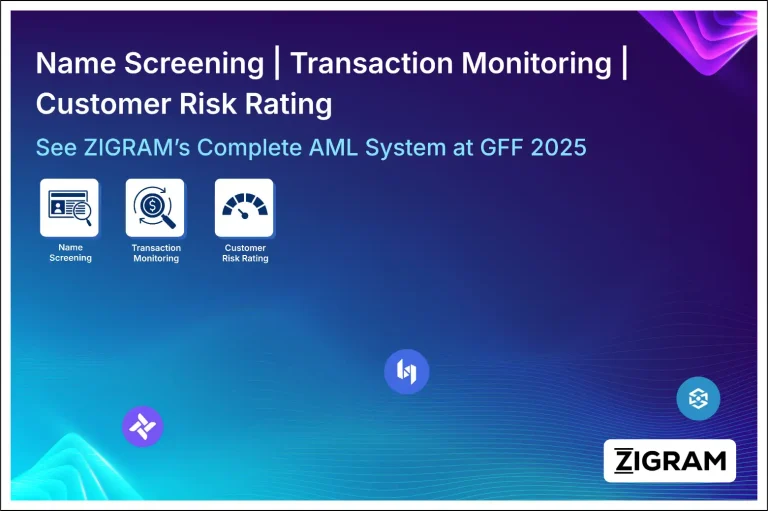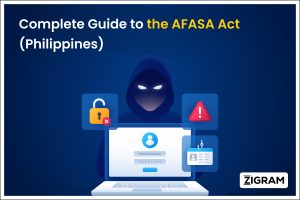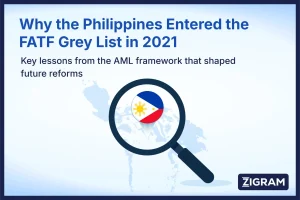Table of Contents
In an era where finance is becoming ever more global, digital, and interconnected, money laundering remains a critical threat to economic stability, public trust, and the integrity of institutions. According to the United Nations Office on Drugs and Crime (UNODC), approximately 2-5% of global GDP is laundered each year, amounting to somewhere between US$800 billion and $2 trillion. [5]

To respond to this challenge in a meaningful way, we must harness AI, Innovation, and Inclusion. Together, they are transforming how organizations detect, prevent, and manage money laundering risk. Below, we explore real-world case studies, followed by how ZIGRAM’s “Complete AML System” (name screening + transaction monitoring + customer risk rating) aligns with these trends and can help create a safer financial system. To showcase our products we will be live at Global Fintech Fest 2025 (more details at the end) doing demos, answering questions and help everyone who visits us get their perfect AML System for Complete Compliance.
Real Case Studies In India That Shows Growth of AI and Innovation In AML
Here are several initiatives and data points showing how governments are using innovation (including AI) to improve AML, how inclusion and regulation are factored in, and the challenges they face.
Detecting Mule Accounts with AI (2025)
- In February 2025, the Union Home Minister announced that the Indian Government is using AI tools to track mule accounts used in cyber fraud. [1]
- As of that announcement: 1.9 million mule accounts had been identified, and fraudulent transactions worth Rs 2,038 crore prevented. Also, 399 banks and financial intermediaries are coordinating with the government. [1]
- This is a good example of transaction monitoring / augmented data analysis (pattern detection) being used by government bodies to protect citizens, reduce financial crime, and maintain trust.
FIU Reporting Volumes & the Impact of Policy Innovation
- After demonetisation (2016), India’s FIU (Financial Intelligence Unit – India) saw a dramatic spike in Suspicious Transaction Reports (STRs). In 2017-18, over 14 lakh STRs were reported which is a 1,400% jump from before demonetisation. [2]
- This shows how major policy moves (demonetisation is disruptive) require AML systems to scale rapidly, handle large volumes, and maintain processing/analysis speed. It also emphasizes the inclusion side — ensuring that citizens’ legitimate transactions aren’t overly burdened, that legitimate entities are not unduly suspect because of regulatory noise. [2]
- Also, in FY18, FIU forwarded 65,829 STRs to law enforcement (highest at that time) — demonstrating government detection activity.
FIU’s Detection of “Black Money” via STRs & Cross-Agency Use
- In 2013-14, the FIU registered ~61,953 STRs (double what was in the prior year). This led to detection of illegal income of ~ Rs 7,800 crore (≈ USD ~1-1.2 billion depending on exchange rate) via various enforcement agencies. [3]
- The I-T (Income Tax) Department, Customs, etc., used these STRs. This shows how government AML systems, when well-designed, feed into downstream enforcement, regulatory uses, and cross-agency action. The inclusion dimension here includes ensuring reporting entities (banks, financial institutions) are embedded in the system, and enforcement is connected. [3]
Lessons from These Case Studies (with respect to AI, Innovation, Inclusion)
From these, several insights emerge that are directly relevant to shaping future of AML solutions:
Scale & speed matter
Real-time or near real‐time monitoring (as in the RBI sandbox) is crucial to detect and act on suspicious transactions before harm accumulates.
Multi-stakeholder and regulatory alignment
Government bodies (e.g. FIU, Home Ministry, RBI) are working with banks, intermediaries, cybercrime agencies, etc., so alerts and intelligence flow across functions.
Policy shocks (like demonetisation or major regulation) stress AML systems
Innovations in technology (AI, automation) help absorb that stress.
Inclusion isn’t just about customers, but institutions
Ensuring that smaller banks, financial intermediaries, fintechs, and regulators have access to advanced tools, and are part of the network of detection and compliance. Also, ensuring fairness — e.g. flagging does not unfairly penalize PEPs or legitimate actors without basis.
Transparency and oversight
Government initiatives (e.g. regulation, sandboxes) help provide clarity, legal backing, and oversight for technological tools (including AI) in AML.
Innovation & Inclusion: What They Mean and Why They Matter
Innovation
Innovation refers not just to using AI but using adaptive, explainable, graph/network-aware, real-time, behavioral analytics-led systems. Systems that can handle unstructured data (news/adverse media), multiple languages, cross-border flows, digital identities, etc.
Inclusion
Inclusion means ensuring that AML tools do not discriminate, that smaller financial institutions (or in emerging markets) can access affordable and effective AML systems; that risk models consider all types of customers (including under-served ones), and that compliance does not become a barrier to financial inclusion by rejecting large numbers of legitimate customers. Also, inclusive design in the sense of human oversight, transparency, and regulatory alignment across jurisdictions.
Read More: Empowering Inclusive Fintech: How ZIGRAM’s RegTech Innovates Access for All
How ZIGRAM’s “Complete AML System” Fits In AI, Inclusion and Innovation?
To tackle money laundering effectively, financial institutions need a holistic system that does three interlocking things:
- PreScreening.io for Name Screening (sanctions, watchlists, PEPs, adverse media, etc.)
- Transact Comply for Transaction Monitoring (real-time or near-real-time detection of suspicious transactions, anomalous patterns, cross-entity/graph analytics)
- Entity Hero for Customer Risk Rating (profiling customers based on inherent and behavioural risk, combining many data sources, updating over time, enabling prioritization of oversight, KYC / EDD / monitoring accordingly)
Component | Key Features / Capabilities | How it Leverages AI & Innovation | How it Supports Inclusion & Compliance |
Name Screening Module | • Fuzzy matching across multilingual names and transliterations • Sanctions / PEP / watchlist / adverse media checks in real time • Continual updating of external data sources & AI-assisted adjudication & alert triaging | Uses NLP to handle variations, fuzzy matching, natural language ambiguity; leverages external unstructured data; uses AI scoring to reduce false positives; explains decisions for auditability | Enables smaller institutions to use pre-built screening with minimal manual effort; reduces rejection of legitimate customers; supports multi-jurisdiction watchlists; ensures transparency so regulators can understand screening logic |
Transaction Monitoring Module | • Real-time or near real – time monitoring of transactions • Graph/network analysis to detect structuring, layering, cross-account / cross-entity flows • Scenario builder with adaptation to new threat typologies; unsupervised learning for anomalies | Innovation via behaviour analytics, anomaly detection, self-learning models for changing patterns; ability to reduce false positives while increasing detection rates (benchmarks as in case studies) | Keeps operational cost manageable so even smaller players can deploy; inclusion by enabling oversight of accounts/customers that might otherwise be overlooked; better protecting everyday customers by catching illicit activity early |
Customer Risk Rating Module | • Risk scoring combining inherent risk (jurisdiction, business type, beneficial ownership) and behavioural risk (transaction history, patterns) • Dynamic updating with new information (e.g. adverse media, new transactions, external signals) • Visualization of risk levels; prioritised workflows | AI-led model for combining multiple signals; ability to weight them adaptively; graph features to identify hidden exposures; risk scoring models that are explainable | Enables differential treatment (e.g. lighter due diligence for low risk, more for high risk) so resources are focused; helps avoid blanket over-diligence that blocks financial inclusion; support for local/regional risk factors so model adapts to inclusion goals |
Why AI + Innovation + Inclusion are Critical for the Future of AML
- Effectiveness: AI reduces noise (false positives), improves detection of actual suspicious activity, and allows uncovering complex, novel laundering schemes. The case studies above show large improvements (50-90%) in various metrics (false positives, detection, efficiency).
- Innovation enables agility: Payment patterns evolve, criminal methods adapt, regulatory regimes shift (crypto, global flows, etc.). AML systems must be able to learn, adapt, and incorporate new data sources rapidly.
- Inclusion ensures legitimacy and justice: A system that rejects many legitimate customers, or that is opaque, or that imposes heavy cost burdens on smaller entities, or that discriminates, will erode trust, hamper financial inclusion, and could even aid illicit actors by pushing them into less regulated channels. Also, many jurisdictions have different risk profiles; inclusion means designing systems that work globally and locally, not just for large banks in developed markets.
Challenges & Considerations
- Data quality, privacy, and access. AI models are only as good as their data; many countries or institutions may not have clean or comprehensive data, or may run into regulatory/privacy constraints.
- Explainability / auditability. Regulators want to see how decisions are made; black-box models can be problematic if they cannot be justified. Bias and fairness. Risk scoring and customer profiling must avoid unfair treatment or unintended discrimination.
- Cost and integration. Legacy systems, regulatory compliance, internal resistance to change, and the need to integrate across KYC, transaction systems, external sources.
- Regulatory harmonization. AML regulation differs across jurisdictions; cross-border flows often come with conflicting requirements or gaps.
The Road Ahead
- More use of graph analytics, network detection, unsupervised learning for detecting new or evolving laundering typologies.
- Greater adoption of behavioural risk signals, in addition to inherent risk, to make customer risk ratings more dynamic.
- Advances in natural language processing and external data (e.g. adverse media, public records, sanction lists) for name screening and monitoring.
- More AI governance to ensure transparency, fairness, regulatory compliance.
- Designing for affordability and accessibility, so AML systems are usable by smaller financial institutions, fintechs, non-bank institutions.
ZIGRAM at Global Fintech Fest 2025
AI, innovation, and inclusion together are not just buzzwords—they are becoming the foundations of effective, resilient AML frameworks. With money laundering amounting to up to 5% of global GDP, and with traditional systems being overwhelmed by false alerts and missed risks, the need for change is urgent.
At the Global Fintech Fest (GFF) 2025, ZIGRAM will feature prominently among the innovation showcases, presenting its Complete AML System (comprising Name Screening, Transaction Monitoring, and Customer Risk Rating) as a case study in how AI-driven, inclusive, and innovation-led AML tools can support the event theme: Empowering Finance for a Better World – Powered by AI: Augmented Intelligence | Innovation | Inclusion. As an exhibitor, and through product launch and demo sessions, ZIGRAM will demonstrate live how its system reduces false positives, accelerates detection of suspicious behavior (e.g. mule accounts or illicit networks), and enables smaller financial institutions to comply efficiently without imposing undue burden on lower-risk customers. Through roundtables and masterclasses at GFF 2025, ZIGRAM will also engage with regulators such as RBI, policy makers, and other fintech innovators to explore how AML frameworks can be made more adaptive, transparent, and inclusive.
The event will be from 7-9 Oct 2025 in Jio World Center, Mumbai, India.
Join us by booking a free AML demo here.
Bibliography
1. Govt to use AI to track mule accounts in cyber fraud crackdown: Amit Shah – (Business Standard)
2. FIU: 1,400% rise in reporting of shady dealings after demonetisation – (The Times of India)
3. FIU forwarded over 65K reports in FY18, the highest ever – (The Indian Express)
4. FIU detects over Rs 7,800 cr blackmoney; gets record STRs – (Business Standard)
5. United Nations Office on Drug Crimes (UNODC)
- #GENIUSAct
- #Stablecoins
- #AML
- #FinancialCrime
- #Compliance
- #CryptoRegulation
- #FinCEN
- #SanctionsCompliance
- #RegTech
- #AntiMoneyLaundering
- #DigitalAssets
- #FinancialSecurity







